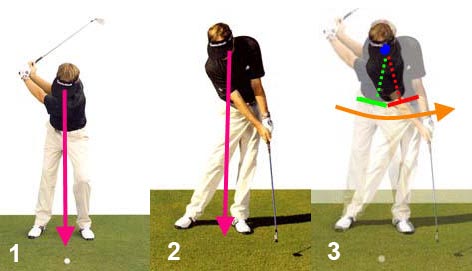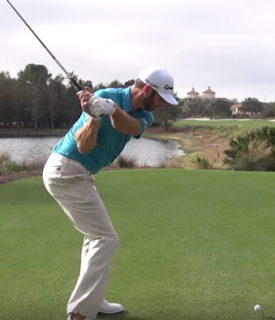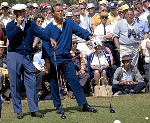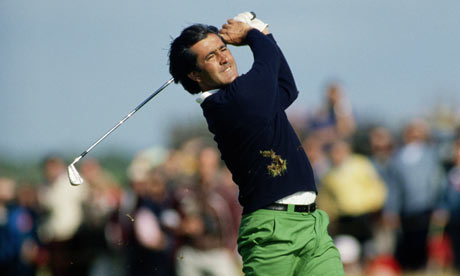|
|
Post by imperfectgolfer on Jan 21, 2010 12:16:57 GMT -5
Many golfers who try the S&T swing state they have no back pain as a result of using that swing pattern. Three important points. 1) Many new S&T golfers are not really performing the S&T swing as described by Bennett/Plummer in their book. They are simply staying more centralised in the backswing, and they really have a rightwards-centralised backswing swing action swing style (like Sean O Hair). Therefore, there is no reason why they should have a greater predisposition to lumbar back pain. A S&T golfer must ensure that he correctly mimics Bennett/Plummer's recommendations - as demonstrated in this composite photo from their book.  Image 1 shows a S&T golfer at the end-backswing position. The pink arrowed line shows that the shoulder center (upper swing center) is vertically over the ball. Note that the upper torso has leftwards-tilt and note that the right pelvis is higher than the left pelvis. Image 2 shows a S&T golfer in the early followthrough (immediately post-impact). Note that he has kept the shoulder center (upper swing center) stationary - the pink arrowed line hasn't moved (relative to the left foot and ball position). Note that the pelvis has shifted far to the left - note that the outer border of the left pelvis is a few inches outside the outer border of the left foot. Also, note that the left pelvis is now a few inches higher than the right pelvis. Image 3 - I used the Adobe Photoshop program to make image 2 proportionately smaller in size, so that I could superimpose image 2 over image 1 to produce a composite image (consisting of image 1 and image 2). This composite image gives one a good impression of how much the lower body moves in a S&T downswing. The blue dot represents the shoulder center (upper swing center) and one can see that it essentially remains stationary during the downswing. The green dotted line shows the spine tilt at the end-backswing position, and the red dotted line shows the spine tilt immediately post-impact. The change in spine tilt angle (as seen from face-on) is due to the aggressive left-lateral pelvic shift motion - represented by the curved orange arrowed line. I made the orange arrowed line curved to show that the pelvis not only moves left-laterally - the pelvis also changes its tilt-angle from being right-uptilted at the start of the downswing (solid green line) to being left-uptilted (solid red line) at impact. The key point that a golfer needs to understand about the S&T downswing is that the majority of the left-laterally directed spine movement occurs at the level of the lower spine (lumbar spine) and not at the level of the mid-upper thoracic spine (as occurs in the traditional/conventional swing). 2) The second point is that the human lumbar spine is very resilient, and it may take 10-40 years of abuse (excessive left-lateral latriflexion forces at the level of the lumbar spine) to produce lumbar spine damage. I would not expect a healthy young person to have any back pain in the first few years of using the S&T swing (as described by Bennett/Plummer). 3) One cannot decide whether the S&T swing increases the risk of chronic back problems - based on anecdotal experience (individual/personal experience). A researcher would need to perform a clinical study to determine whether the S&T swing significantly increases the risk of chronic lumbar spine injury. I have described the complexities involved in designing, and interpreting, that type of study in this short paper. perfectgolfswingreview.net/stackstudy.htmJeff. |
|
|
|
Post by iacas on Jan 26, 2010 16:20:53 GMT -5
Many golfers who try the S&T swing state they have no back pain as a result of using that swing pattern. If you're going to put forth the idea that average players don't feel back pain while doing S&T because they're doing it wrong, then the empirical data available on the PGA Tour would seem to contradict that just a bit: so far as I know, none of the S&T pros have missed a tournament due to back pain, and many have commented that their backs feel better. Your post seems to suggest that they'll be in misery in 40-60 years, but it seems more likely that a swing that causes pain now will cause more pain later than one which causes no pain now. But others far more well versed in S&T have have responded to your post, so aside from my comment above, and the admittedly meaningless point that my back feels better with S&T than it did before, I'll leave it at that except to say that I think your article may warrant a discussion thread of its own (though I'd suggest that this is not that thread). As for my experience with S&T, I was a "doubter" in 2007 largely because I found the pictures in Golf Digest - of both the "conventional" swing and of Badds, to be far too exaggerated. My "conventional" swing (or what I thought was conventional) looked nothing like the images they showed, and I shelved considering S&T while working on my swing by myself. Cut to 2009 and I work with an S&T instructor and find out that I'd already been "stacking" and doing the left side tilting on my own because I'd independently discovered the value of keeping my upper swing center relatively in place. The things I've had to work on have been a better hand path (my went straight back instead of staying on the plane) and more hip push forward. My ball striking has improved. Distance has improved. My understanding of why a shot flew the way it did has improved, and I can control my shots far better than I used to. I didn't make a lot of progress last year on working on the two things I'm working on because I had a full playing schedule, but I'm using this winter to really get those things nailed down and am already seeing much improved results. (Quite frankly, sometimes I wonder how I broke 90 let alone par a few times with my "old" swing when I see it on video and compare it to my motion now.) Y'know, like Homer Kelley said, basically "keep making the right moves even if you miss the ball..." winter (and hitting in a golf dome) has let me work on making the better moves and not worrying about where the ball goes. The best thing about S&T - to me - is the simplification. A lot of what I'd call "timing elements" are removed or minimized. For example, I've always been a fan of a more one-plane type swing because the timing of the arm drop added an element. I've never liked the "release the club" advice, and S&T prefers that you maintain the flying wedge in your right wrist (forearm/shaft) well through impact. The steady upper center removes the need to time the slide back into position. With my old swing, the hips would often spin out too fast, but now I can just push them forward and not worry about the spinning - that happens automatically (for me, anyway). Currently, I can not swing a golf club for a few weeks and, within a few practice swings, be right back where I need to be and where I left off. Sometimes with my old swing it took quite awhile for the "timing" to come back. The full S&T isn't for everyone, but the simplicity and a few of the pieces are for everyone. I think the swing has a target because it has a name, while someone like Mike Bender teaches a very similar swing except for a piece or two, and Ben Hogan's swing had a lot of the same pieces, and on down the line. It's really not that different, not once you study it. At least, IMHO. |
|
|
|
Post by kevcarter on Jan 26, 2010 16:42:19 GMT -5
Keep it going, IMO, S&T is a fantastic pattern for many, and more importantly, has a lot of people excited about golf again. It's a really fun culture!
Kevin
|
|
johngrahamgolf
'88 Apex Redlines
   3Jack Top 20 Short Game/Putting Instructor
3Jack Top 20 Short Game/Putting Instructor
Posts: 229
|
Post by johngrahamgolf on Jan 28, 2010 21:55:09 GMT -5
Ok, so I'm about half way through "The Stack and Tilt Swing" and there appears to be a common theme. To hit a push draw the clubface must be open to target and a pull slicer has a closed face. Pg 37 and 38 it talks about a slicer having a hard time getting the ball in the air once their swing is from the inside because the closed clubface takes too much loft off the shot.
I know what they are trying to say but I totally disagree with this explanation. The clubface, IMO, can only be open, square or closed to the path. I think it is very improper to say open, square or closed relative to the target. Using right, at the target, or left would be much better terminology for the following reasons.
1) when you hit a push draw, the face isn't open. An open face is one where at impact the face points right of the path. A push draw has a face right of the target but closed(left) to the path.
2) I would also say that an open face has more loft than a square or closed face. I also don't believe that a push draw has more loft than a push or push fade.
It is not OPEN.
I have tried very hard to remove that vernacular from my teaching. I think it confuses people and is wrong.
Other than that, the book has been enjoyable for as far as I've read.
|
|
|
|
Post by chipper3344 on Jan 31, 2010 19:51:24 GMT -5
The face is open but closed relative to the path. That's the only way to hit a proper push draw that does not cross the intended target line.
A face that is open has less loft. Think of a driver that is stamped 9.5*. If the face is 1.5* open the effective loft is only 8*.
|
|
johngrahamgolf
'88 Apex Redlines
   3Jack Top 20 Short Game/Putting Instructor
3Jack Top 20 Short Game/Putting Instructor
Posts: 229
|
Post by johngrahamgolf on Jan 31, 2010 22:10:19 GMT -5
The face is open but closed relative to the path. That's the only way to hit a proper push draw that does not cross the intended target line. A face that is open has less loft. Think of a driver that is stamped 9.5*. If the face is 1.5* open the effective loft is only 8*. Effective loft is the loft remaining after you make the face square. I'm sure you are not saying the more I open the face the less loft I get? I don't think it helps people to say the face is open to the target. Just say it points right of the target. After that, there is nothing open about the clubface. |
|
|
|
Post by Richie3Jack on Jan 31, 2010 23:58:24 GMT -5
What is S&T's position on:
1. Shoulders at impact (Square, Open, Closed, does it matter?)
2. Right forearm at impact (on plane, above plane, does it matter?)
3JACK
|
|
|
|
Post by iacas on Feb 1, 2010 19:41:08 GMT -5
I don't think it helps people to say the face is open to the target. Just say it points right of the target. After that, there is nothing open about the clubface. I disagree. I find it easier to think of the face as being open relative to the target. Plus, lefties don't have to flip everything if you say the face is open relative to the target like they would if you say the face is pointing right of the target. |
|
|
|
Post by iacas on Feb 1, 2010 19:48:24 GMT -5
The key point that a golfer needs to understand about the S&T downswing is that the majority of the left-laterally directed spine movement occurs at the level of the lower spine (lumbar spine) and not at the level of the mid-upper thoracic spine (as occurs in the traditional/conventional swing). I disagree with that. Just because the hips go forward - as they do in every good golfer's swing - the lumbar spine doesn't necessarily tilt or curve. It simply moves with the hips. The spine doesn't tilt in the lumbar area - it still occurs further up in the thorax up to the shoulders. Your lumbar region doesn't really bend sideways much. It can flex and extend, and that's about it. I've talked to doctors who have actually studied the swing who disagree with you, so I'm goign to go with what they've said because it matches what I've felt and seen myself. P.S. You seem to misunderstand the "left leaning" or "left tilt" too. The golfer's spine is not actually supposed to lean towards the target at the top of the backswing. |
|
|
|
Post by imperfectgolfer on Feb 1, 2010 23:42:16 GMT -5
iacas We see "reality" differently. Here is Mike Bennett's S&T swing.  Consider the movements of the lower body and spine in the S&T swing. Image 1 shows a S&T golfer at the end-backswing position. The pink arrowed line shows that the shoulder center (upper swing center) is vertically over the ball. Note that the upper torso has leftwards-tilt and note that the right pelvis is higher than the left pelvis. Image 2 shows a S&T golfer in the early followthrough (immediately post-impact). Note that he has kept the shoulder center (upper swing center) stationary - the pink arrowed line hasn't moved (relative to the left foot and ball position). Note that the pelvis has shifted far to the left - note that the outer border of the left pelvis is a few inches outside the outer border of the left foot. Also, note that the left pelvis is now a few inches higher than the right pelvis. Image 3 - I used the Adobe Photoshop program to make image 2 proportionately smaller in size, so that I could superimpose image 2 over image 1 to produce a composite image (consisting of image 1 and image 2). This composite image gives one a good impression of how much the lower body moves in a S&T downswing. The blue dot represents the shoulder center (upper swing center) and one can see that it essentially remains stationary during the downswing. The green dotted line shows the spine tilt at the end-backswing position, and the red dotted line shows the spine tilt immediately post-impact. The change in spine tilt angle (as seen from face-on) is due to the aggressive left-lateral pelvic shift motion - represented by the curved orange arrowed line. I made the orange arrowed line curved to show that the pelvis not only moves left-laterally - the pelvis also changes its tilt-angle from being right-uptilted at the start of the downswing (solid green line) to being left-uptilted (solid red line) at impact. The key point that a golfer needs to understand about the S&T downswing is that the majority of the left-laterally directed spine movement occurs at the level of the lower spine (lumbar spine) and not at the level of the mid-upper thoracic spine (as occurs in the traditional/conventional swing). Now, if you do not agree that most of the left-laterally directed spinal motion is occurring at the level of the lower half of the spinal column, rather than the upper half, then we perceive "reality" differently. It is true that the lumbar spine moves left-laterally with the pelvis (because it has no choice), and that is why it is being subjected to a large amount of latriflexion force. Jeff. |
|
joec
'88 Apex Redlines
  
Posts: 161
|
Post by joec on Feb 3, 2010 12:39:53 GMT -5
there are some lessons on u tube from martinez 19696. has anyone viewed them. what do you think? is this stack and tilt?
|
|
|
|
Post by gmbtempe on Feb 3, 2010 13:01:43 GMT -5
there are some lessons on u tube from martinez 19696. has anyone viewed them. what do you think? is this stack and tilt? Martinez seems like a great instructor but I don't believe he is a stack and tilt teacher. |
|
|
|
Post by kevcarter on Feb 3, 2010 13:28:42 GMT -5
there are some lessons on u tube from martinez 19696. has anyone viewed them. what do you think? is this stack and tilt? Martin is not S&T. He's come up with his own program, and it's excellent. Very good teacher for those who are interested in pivot driven swings... Kevin |
|
|
|
Post by mudball on Feb 6, 2010 13:08:50 GMT -5
Questions re S&T and playability.
Looks like a punch shot to me... that was my initial thought.
For those who are doing it...
Can you vary ball trajectory and how is that achieved in S&T terms
Can you shape ball fade/draw and again (I know how to hit a fade) I mean in S&T terms.
What do you think about the distance question - d you lose distance - I heard some lost a min of one club?
Any other issues ? such as hanging lies or uphill shots - is it versatile for all terrain?
Why I am sceptical - Aaron Baddeley has one of those physiques and timing and general style which would make swinging on his knees with one arm in the air look half decent...
I have a bad back and neck due to a motor cycle accident and disks that really belong in someone 20 years older than me and I'm not young! I was put off when I heard the bad back stories - but then on the other hand golf is a game that is bad for the back classic or modern - it is a game that stresses the back so I'm unclear if S&T would be a latent problem for golfers and any worse than any other swing.
I don't want to lose a bunch of distance - as I know that will just make me try harder - but I'm thinking I've spent the best part of 20 years around my current handicap - so if I'm going to get of this plateau I need to try something different...
|
|
|
|
Post by gmbtempe on Feb 6, 2010 13:14:30 GMT -5
My experience
1. I could not hit a fade with the swing, it promotes a push draw, if you get the face open to the path for a fade its going to be a push fade and while thats a fine shot I never could make it happen.
2. I had trouble getting the longer clubs into the air
3. I lost distance with all clubs
4. I had no issues with lies
5. No problems for my back which can be iffy at times
6. Great pattern for shorter clubs, not sold on the longer ones.
7. I actually think this may be a very good pattern from the very high handicapper who struggles to make good contact.
|
|








